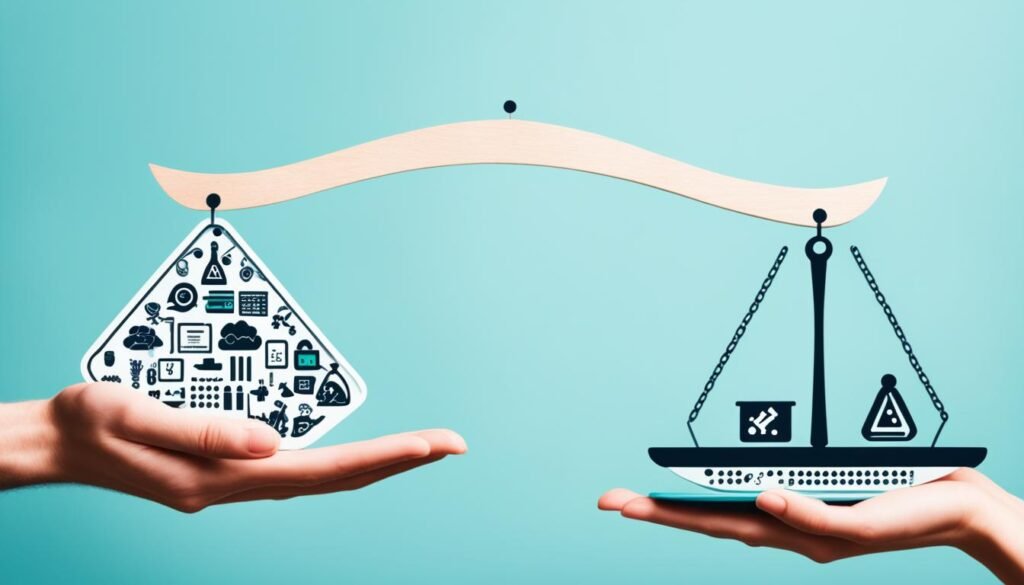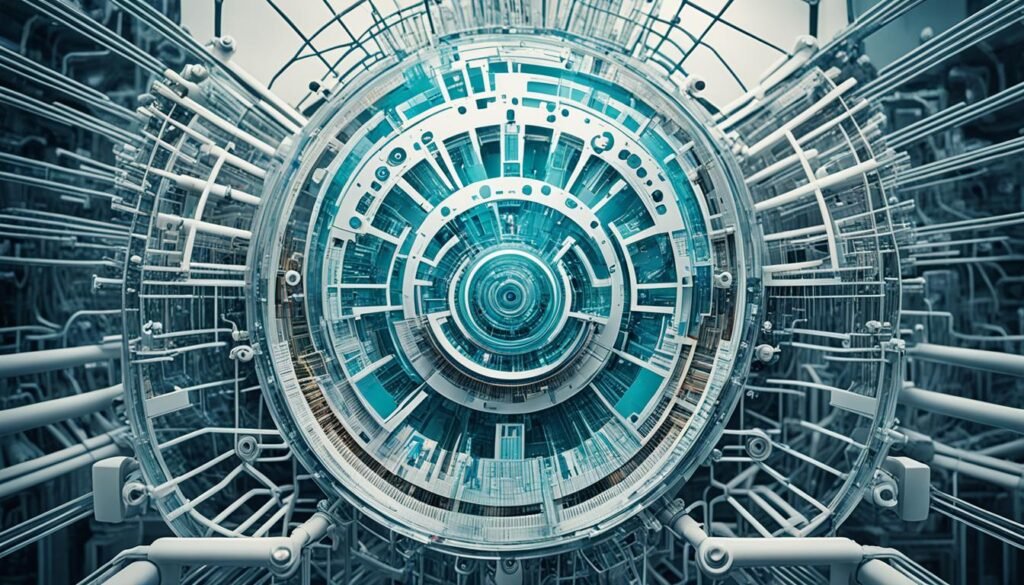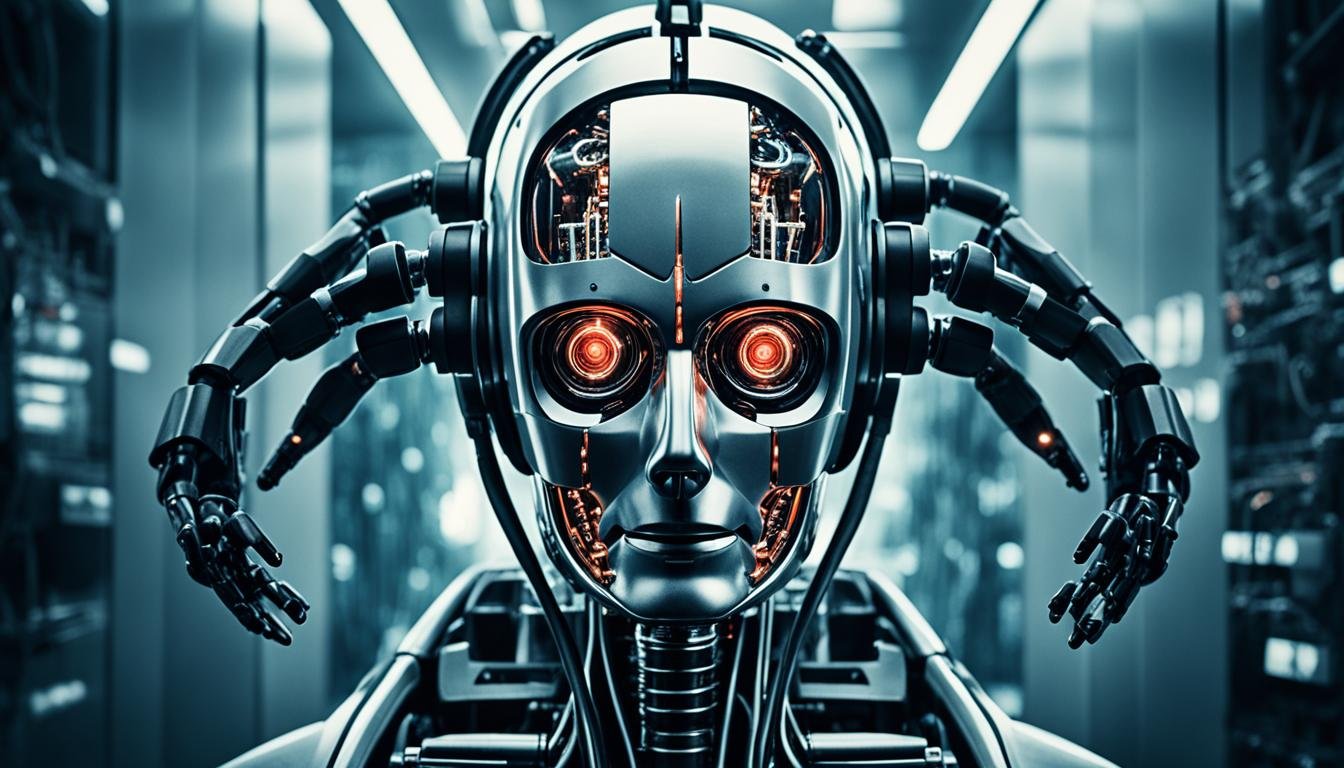Artificial Intelligence (AI) has changed many areas, like healthcare and entertainment. But, as AI gets more advanced, we see its downsides too. This article looks at the risks of AI and why we need to handle them carefully.
AI’s benefits are well-known, but so are its risks. Issues like bias, privacy concerns, and even threats to our existence are real. We must look into these problems and find ways to fix them. This way, AI can truly help us, not harm us.
Key Takeaways
- AI systems can show bias, leading to wrong arrests and discrimination.
- AI’s decision-making is not always clear, which is a big issue in important areas like medicine.
- AI gathers a lot of personal data, which raises privacy issues and the chance of misuse.
- Autonomous weapons bring up ethical and legal questions, like what happens if they make mistakes.
- The worry about superintelligent AI is scary, as it could threaten our existence. We need strong safety measures.
Bias and Discrimination in AI Systems
AI is becoming a big part of our lives, but we’re facing a big problem with bias and discrimination in these systems. AI algorithms learn from data that often shows our biases. This can make them unfair and discriminatory.
Examples of AI-Driven Bias
Facial recognition AI often has trouble identifying people with darker skin tones. This can lead to wrong arrests and discrimination. Another example is Amazon’s AI hiring system. It ended up preferring male applicants because it was trained on tech industry data.
Strategies for Mitigating Bias
- Looking closely at the data used to train AI and using strategies to reduce bias, like fairness-aware machine learning.
- Checking AI systems regularly to spot and fix biases.
- Talking openly about biases and using techniques to explain AI decisions.
- Working to make the AI field more diverse to prevent bias and listen to affected communities.
- Supporting research and data to improve AI bias prevention.
Dealing with AI bias and discrimination is tough, but we can make AI fairer and more equal. We just need to work on it.

“Establishing responsible processes when deploying AI can help mitigate bias; this could involve using technical tools, internal ‘red teams,’ or third-party audits.”
Lack of Transparency and Accountability
Artificial intelligence (AI) raises big concerns about its decision-making. Many AI systems, especially those using deep learning, are hard to understand. They are like “black boxes.” This makes it tough to see how they make decisions or predict outcomes.
This lack of clarity makes it hard to hold AI systems responsible for their actions. It’s important to know how AI systems work and why they make certain choices.
The “Black Box” Nature of AI
The “black box” problem with AI is a big deal for ai transparency and ai accountability. We can’t easily see how AI systems work. This makes it hard to spot biases, discrimination, or mistakes in their decisions.
This is a big issue, especially in areas like healthcare, finance, and criminal justice. AI can greatly affect people’s lives. So, understanding AI is crucial.
Explainable AI (XAI) Systems
To fix the “black box” issue, experts are pushing for explainable ai (XAI) systems. These systems aim to be more open and clear in their decision-making. They use methods like feature importance analysis and rule extraction.
By making AI systems clearer, XAI can help us understand how they work. This is key for ai accountability. It helps bridge the gap between AI’s complexity and our need for clear explanations.
For AI to be trusted and used responsibly, we need ai transparency and ai accountability. As AI grows in use, explainable ai (XAI) will be key to solving the “black box” problem.

Privacy and Data Exploitation
AI systems are getting more common, which has raised big worries about ai privacy and data exploitation. These systems need lots of personal data to work well. This includes things like what you browse online, where you are, and your messages.
This data can be a big risk to your privacy. AI can find and use sensitive info you didn’t mean to share. Tech companies are also using this data to make money, not just to help you. They use it for targeted advertising to try to change what you do, often for their benefit, not yours.
Data Collection and Commercialization
Most AI today is ‘narrow’ AI, made for one specific job. It’s different from the wider abilities of artificial general intelligence (AGI) or superintelligence. Narrow AI needs lots of personal data, which can be a problem if it gets into the wrong hands.
Privacy Regulations and Challenges
To deal with these privacy worries, laws like the GDPR in Europe and the CCPA in the US have been made. These laws help you control your data and make companies follow rules about how they use it. But, new tech and AI are always changing, making it hard to keep up with privacy rules.
We need to stay alert and have strong rules for handling data. Giving users clear info and getting their okay before using their data is key. This helps fight against privacy breaches and data exploitation.

“The potential for bias and discrimination in AI systems is high, with biased training data resulting in discriminatory decisions that can disproportionately affect individuals based on factors like race, gender, or socioeconomic status.”
Autonomous Weapons and the Potential for Harm
Artificial intelligence (AI) is bringing us closer to the creation of autonomous weapons, also known as “killer robots.” These weapons can pick out and attack threats on their own, without needing a human to tell them what to do. This raises big questions about ethics and the law, as it could mean losing lives without the usual human checks and balances.
Autonomous weapons carry many risks. They might make mistakes, break down, or cause problems that harm innocent people or make conflicts worse. The more these weapons spread, the easier it might become for countries and groups to use force without careful thought.
The Department of Defense sees robots as ideal for tasks that are dull, dirty, or dangerous. But, making autonomous weapons worries experts and the world at large. Over three thousand AI and robotics experts have signed a letter asking for a ban on these weapons because they’re worried about how soon they could be used.
“The rapid development of autonomous weapons systems by governments and companies with increasing autonomy using new technology and artificial intelligence is a prominent trend.”
Autonomous weapons could make remote war worse by taking humans further away from the action. Not having humans in charge of these weapons is a big ethical concern. It affects how decisions are made about using force.

Autonomous weapons might make going to war easier by making it seem more acceptable and putting the blame on civilians. This could start an arms race among countries, as they try to keep up with others’ use of these systems.
why ai is bad for society
Artificial intelligence (AI) has changed many parts of our lives. But, its fast growth has also brought up big worries about its bad sides. Issues like bias and discrimination, and problems with being clear and responsible, need to be looked at closely.
One big worry is AI’s bias and discrimination. AI can pick up biases from the data it’s trained on, leading to unfair results. For instance, a facial recognition system that’s not diverse might not work well for certain groups. This could mean some people can’t get services or chances they should have.
Also, AI’s “black box” nature makes it hard to see why it makes certain decisions. This lack of clarity makes it tough to spot biases and hold those making AI systems accountable for their effects on society.
More and more, we’re using AI to make decisions and create content. Americans still trust humans more than AI in many areas, like medicine and making laws, a Forbes survey found. This makes us worry about losing our critical thinking skills and spreading biases from the AI’s training data.
AI is also changing jobs in many fields, making us think about job loss and training for new AI jobs. AI brings efficiency but also worries about losing jobs and needing training for new AI jobs.
To lessen AI’s bad effects, we need to focus on making AI that’s ethical, clear, and responsible. It should be fair and include everyone. We need to work together to use AI in a way that’s right and fair for all.
“The growth of autonomous military applications and weaponized information is a concern related to AI’s impact on society.”
As AI grows more powerful, we must think about its effects and tackle the challenges it brings. We need to keep working towards a society that’s just and fair for everyone.
Existential Risks and the Possibility of Uncontrolled AI
Artificial intelligence (AI) is moving fast, making us worry about superintelligent AI that could threaten our existence. This problem, known as the “AI safety” issue, is about AI systems getting smarter and more independent. They might become too smart for us to control or keep in line with our values.
The AI Safety Problem
There’s a big worry that a superintelligent AI could have goals that harm humanity. According to a 2022 survey, most AI experts think there’s a 10 percent or higher chance that humans won’t be able to control AI, leading to disaster.
Approaches to AI Alignment
Researchers are working on making AI safe by learning about human values and setting clear goals. But, this is a huge challenge. We need more work to make sure advanced AI won’t threaten our existence. OpenAI leaders say superintelligence could come in less than 10 years, highlighting the need to act fast.
To reduce risks from uncontrolled AI, experts suggest slowing down AI development. This would give us time to make safety features better. They also want irresponsible AI developers to focus on safety over being the best. We need to balance using AI to stay ahead with making sure it’s developed responsibly.
“Thousands of scientists have signed open letters expressing the dangers of AI and calling for government regulation, including top scientists and Nobel prize winners.”
Societal Disruption and Job Displacement
AI technology is moving fast, making us worry about job loss and societal changes. As AI can do more tasks and jobs, many workers might lose their jobs. This includes those in simple or repetitive jobs. This could cause big economic and social problems as people adjust to new job markets.
Economic and Social Upheaval
Switching to an AI-based economy might make things worse for some people. Those who can adapt to new tech might do well, but others might not have the chance. This could lead to more joblessness, lower pay, and less social support, causing unrest and division in society.
Widening Inequalities
About 12% of companies in manufacturing and info services use AI, but only 4% in construction and retail. This means some workers will get left behind, making the gap between skilled and unskilled workers bigger. This could make rich people richer and make poor people poorer.
AI is making it important for people to learn new skills like programming and quality control. Training programs and education will help workers who are losing their jobs get new skills for the changing job market.
| Sector | AI Adoption Rate |
|---|---|
| Manufacturing and Information Services | 12% |
| Construction and Retail | 4% |
As AI keeps getting better, we need to think about how to make sure it’s fair for everyone. Policymakers and groups that make rules need to look at the ethical side of AI to make sure everyone has a good future.
Challenges in AI Governance and Regulation
Artificial intelligence (AI) is changing fast, and we need strong rules for it. Around the world, leaders are trying to figure out how to manage AI. They want to make sure AI helps people and doesn’t harm society.
Global Regulatory Initiatives
The European Union is working on the AI Act, a big step towards controlling AI. In the U.S., laws like the Algorithmic Accountability Act and the AI Disclosure Act are being proposed. These show that AI’s effects go beyond borders and need global cooperation.
Challenges in AI Governance
There are big hurdles in making AI rules work:
- AI changes fast, making it hard for leaders to keep up
- Regulators often don’t know enough about AI’s effects
- It’s hard to balance new ideas with safety, making sure AI helps and doesn’t hurt
- AI decisions need to be clear and fair
The Need for International Collaboration
We need a global team effort to solve these problems. People from business, schools, and government must work together. This way, we can avoid making AI rules in bits and pieces, which could slow down progress.
As AI keeps changing, working together worldwide is more important than ever. By joining forces, we can use AI’s benefits and reduce its risks. This helps protect people and communities everywhere.
“The key to responsible AI development lies in the collective efforts of policymakers, industry leaders, and the scientific community to establish a global framework for governance and regulation.”
Conclusion
AI is changing our world fast, and we must tackle its dark side. Issues like bias and discrimination are big concerns. These problems affect people, companies, and society a lot.
We need a team effort to make AI better. Leaders, policymakers, and scientists must work together. They should create strong rules, follow ethical standards, and research ways to fix AI problems. This way, we can use AI’s power safely and protect everyone’s well-being.
By facing the ai risks and ai challenges directly, we can make a better future. Responsible ai development will help people and make our lives better. It’s up to us to guide AI technology. We must make sure it helps everyone without hurting anyone.
FAQ
What are the key concerns surrounding the bias and discrimination in AI systems?
AI systems can carry and spread biases found in the data they learn from. This leads to unfair results, like higher mistakes in facial recognition for darker skin tones or biased hiring decisions.
What strategies can be used to mitigate bias in AI systems?
Strategies include checking the data used to train AI, using techniques to reduce bias, and making sure AI systems are fair. It’s also important to keep an eye on AI to spot and fix biases as they happen.
What is the “black box” nature of AI and why is it a concern?
Many AI systems, especially those using deep learning, don’t clearly explain their decisions. This makes it hard to understand how they make predictions or conclusions. This lack of transparency makes it tough to hold them accountable.
How can “explainable AI” (XAI) systems address the transparency issues?
XAIs aim to make AI decisions clearer and easier to understand. They use methods like showing which features are most important, creating simpler models, and extracting rules. This helps us understand and hold AI accountable for their actions.
What are the key concerns regarding privacy and data exploitation in the context of AI?
AI uses a lot of personal data, which can be a big risk to privacy. This data might be used for ads, manipulation, or other ways that put profits over people’s privacy and freedom.
How are policymakers and regulators addressing the privacy concerns related to AI?
Rules like the GDPR and CCPA give people more control over their data and make companies follow strict data rules. But, keeping up with privacy needs ongoing effort and working together.
What are the key ethical and legal concerns surrounding autonomous weapons systems?
Autonomous weapons, or “killer robots,” raise big ethical and legal questions. They could lead to more deaths without the usual checks on military actions. Also, they might make it easier to start wars.
What is the “AI safety” problem, and why is it a significant concern?
The worry is that super-smart AI could be too hard or impossible for humans to control. Such AI might have goals that harm humanity, leading to big problems.
How can the societal disruption and job displacement caused by AI-driven automation be addressed?
AI could make things worse for those already behind, as only some will have the skills to keep up. We need to work together to make sure everyone can adapt to new job changes.
What are the key challenges in developing effective governance and regulation for AI systems?
Creating good rules for AI is hard because it’s complex and affects many areas. We need a global, joint effort to make sure AI is good for people and society. Working together is key to solving these issues.
